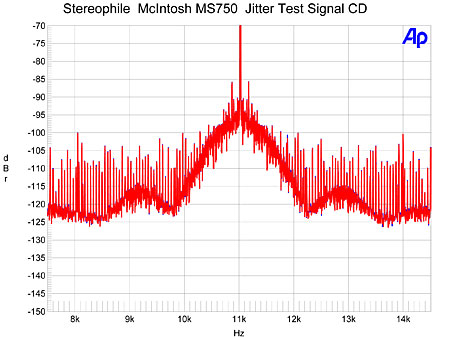This is a review and detailed measurements of the SMSL Sanskrit 10th budget DAC. It retails for USD $100 on Amazon including shipping. I purchased mine (I think) from Massdrop at discount.
From pictures posted by SMSL, the unit looks like large plastic Lego pieces. Fortunately in person it looks quite a bit better:

Remarkably at this price, the unit comes with a remote control. It also has three inputs: USB, S/PDIF and Toslink optical.
There is also a cute gimmick of the display rotating depending on whether you put it horizontal or vertical.
There are separate USB power inputs depending on whether you want to just use USB or S/PDIF. All my testing was done with the USB input jack.
If the performance is there, this would be quite a nice DAC to have. Let's see what the measurements show.
Measurements
I powered the unit and hooked it up via USB and was greeted with this disappointing dashboard:

It was so unusual that I created a quiz to see if anyone could guess what it was. We have pretty elevated low frequency noise below our 1 kHz tone and lots and lots of spurious tones, dragging the SINAD (signal over distortion and noise) to a very poor 80 dB.
Switching inputs to S/PDIF though, substantially improved the situation:

Gone is the low frequency noise. We still have the spike at 500 Hz but overall, we are doing well with a SINAD of 101 dB on the average.
What is strange is that the output level changes depending on which digital input is used (2.04 volts versus 2.1).
Overall this how the distortion and noise compared to other DACs tested:

All the rest of the tests showed similar differential in performance. Here is jitter for example:

I like to see spikes below 120 dB and here we are way up at -80 with USB.
This is how the noise and distortion distribute at different frequencies:

So something is up at lower frequencies.
Multitone signal shows the same story:

The gap in linearity is smaller though (and mimics that if Topping DX3 Pro to some extent):

Do we need to keep running tests? No.
Conclusions
The SMSL Sanskrit 10th set out to change the game in budget DACs with different looks and inclusion of remote control. Alas, with the all common USB input, it completely fails the performance test. If you have S/PDIF output somehow, then it makes a good choice but otherwise, I highly recommend looking elsewhere for your budget DAC needs.
EDIT: with input from SMSL engineers, the USB port is under powered. Using an external power supply restores full performance. See: https://www.audiosciencereview.com/...ts-of-smsl-sanskrit-10th-dac.5702/post-127278. Assuming that you use an external power supply with Sanskrit 10th, I can now recommend it.
-------------
As always, questions, comments, recommendations, etc. are welcome.
If you like this review, or even if you don't but wish for me to have wagyu steak tomorrow, please consider donating funds using:
Patreon: https://www.patreon.com/audiosciencereview)
or upgrading your membership here though Paypal (https://audiosciencereview.com/foru...eview-and-measurements.2164/page-3#post-59054).
From pictures posted by SMSL, the unit looks like large plastic Lego pieces. Fortunately in person it looks quite a bit better:
Remarkably at this price, the unit comes with a remote control. It also has three inputs: USB, S/PDIF and Toslink optical.
There is also a cute gimmick of the display rotating depending on whether you put it horizontal or vertical.
There are separate USB power inputs depending on whether you want to just use USB or S/PDIF. All my testing was done with the USB input jack.
If the performance is there, this would be quite a nice DAC to have. Let's see what the measurements show.
Measurements
I powered the unit and hooked it up via USB and was greeted with this disappointing dashboard:
It was so unusual that I created a quiz to see if anyone could guess what it was. We have pretty elevated low frequency noise below our 1 kHz tone and lots and lots of spurious tones, dragging the SINAD (signal over distortion and noise) to a very poor 80 dB.
Switching inputs to S/PDIF though, substantially improved the situation:
Gone is the low frequency noise. We still have the spike at 500 Hz but overall, we are doing well with a SINAD of 101 dB on the average.
What is strange is that the output level changes depending on which digital input is used (2.04 volts versus 2.1).
Overall this how the distortion and noise compared to other DACs tested:
All the rest of the tests showed similar differential in performance. Here is jitter for example:
I like to see spikes below 120 dB and here we are way up at -80 with USB.
This is how the noise and distortion distribute at different frequencies:
So something is up at lower frequencies.
Multitone signal shows the same story:
The gap in linearity is smaller though (and mimics that if Topping DX3 Pro to some extent):
Do we need to keep running tests? No.
Conclusions
The SMSL Sanskrit 10th set out to change the game in budget DACs with different looks and inclusion of remote control. Alas, with the all common USB input, it completely fails the performance test. If you have S/PDIF output somehow, then it makes a good choice but otherwise, I highly recommend looking elsewhere for your budget DAC needs.
EDIT: with input from SMSL engineers, the USB port is under powered. Using an external power supply restores full performance. See: https://www.audiosciencereview.com/...ts-of-smsl-sanskrit-10th-dac.5702/post-127278. Assuming that you use an external power supply with Sanskrit 10th, I can now recommend it.
-------------
As always, questions, comments, recommendations, etc. are welcome.
If you like this review, or even if you don't but wish for me to have wagyu steak tomorrow, please consider donating funds using:
Patreon: https://www.patreon.com/audiosciencereview)
or upgrading your membership here though Paypal (https://audiosciencereview.com/foru...eview-and-measurements.2164/page-3#post-59054).
Last edited:

